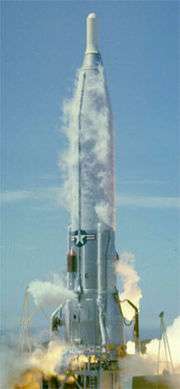RTV-A-2 Hiroc
| MX-774 | |
|---|---|
 | |
| Production history | |
| Designer | Consolidated-Vultee |
| Designed | 1946 |
| Specifications | |
|
| |
Operational range | 1,500 to 5,000 mi. (2,400 to 8,000 km) |
The RTV-A-2 Hiroc (High-altitude Rocket) was the United States' first attempt at an intercontinental ballistic missile (ICBM). In 1946, Consolidated-Vultee was given an Army Air Forces research contract and began design and development of the MX-774, which led to Convair's development of the Atlas ICBM.[1] Although the MX-774 itself was cancelled, three prototype launch vehicles were built, designated RTV-A-2. The three rockets were launched in July, September, and December 1948, all three launches being considered partial successes.[2]
References and notes
- ↑ York, Herbert Jr (1978). "Race to Oblivion: A Participant's View of the Arms Race". Simon and Schuster. p. 56. Retrieved 2008-10-23.
- ↑ Parsch, Andreas (2005). "Convair RTV-A-2 Hiroc". Directory of U.S. Military Rockets and Missiles - Appendix 1: Early Missiles and Drones. Designation-Systems. Retrieved 2014-04-10.
This article is issued from Wikipedia - version of the 9/25/2016. The text is available under the Creative Commons Attribution/Share Alike but additional terms may apply for the media files.
